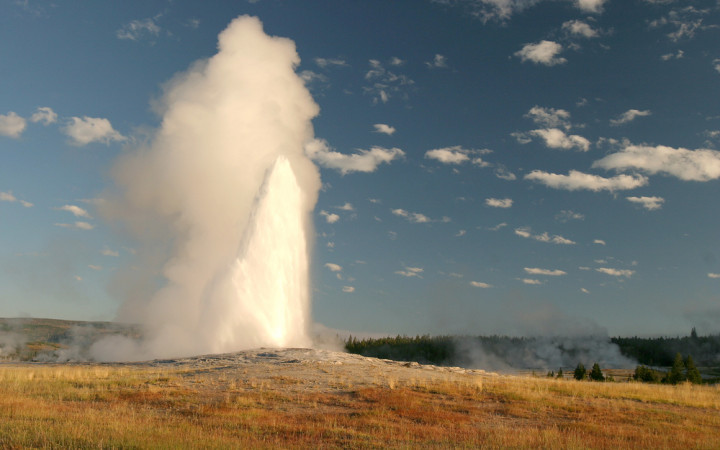Millions of people visit Yellowstone National Park each year. Located mostly in Wyoming (with small parts in Montana and Idaho), Yellowstone draws visitors to its beautiful scenery and wildlife. Yellowstone also offers the chance to view some interesting geological phenomena up close.
No visit to Yellowstone is complete without a trip to Old Faithful. The most famous geyser in America, Old Faithful erupts many times each day to the joy of all those who wait patiently.
A geyser is a natural spring that intermittently spews hot water and steam. Geysers only form under special conditions that are found in only a few places on Earth. As a result, geysers are rare.
Geysers are usually located near active volcanic areas because their formation relies heavily on the presence of magma. When surface water (from a river or lake, for example) filters down deep into the Earth and comes into contact with magma, the magma heats the water very quickly.
This creates a combination of boiling water and pressurized steam that is sent rapidly back to the surface. The geyser effect is then seen when a hydrothermal explosion sends hot water and steam gushing out of the geyser's surface vent.
The word “geyser" comes from Geysir, which is the name of an erupting spring in Iceland. Geysir got its name from geysa, the Icelandic verb that means “to gush."
There are around 1,000 geysers known to exist around the world. Incredibly, about half of those are in Yellowstone! That's why Yellowstone is sometimes called “Geyser Country."
Old Faithful is the most famous of the nearly 500 geysers in Yellowstone. It was named in 1870 by the Washburn-Langford-Doane Expedition. During their stay in the area, the members of the expedition noticed that Old Faithful erupted at regular intervals, thus leading to its name.
Old Faithful's eruptions aren't always the same, though. Eruptions can shoot 3,700 to 8,400 gallons of boiling water to a height of 106 to 185 feet. Eruptions can last from 1.5 to 5 minutes.
More than 70 years ago, Old Faithful would erupt about every 67 minutes. That time has increased to about every 90 minutes today. Scientists believe that earthquakes over the years have affected underground water levels, leading to longer intervals between eruptions.
Today, on average, Old Faithful will erupt about 65 minutes after an eruption lasting less than 2.5 minutes or about 91 minutes after an eruption lasting more than 2.5 minutes. Over time, more than 137,000 eruptions of Old Faithful have been recorded.
In case you're wondering whether geysers have any practical use, they do! In the early days of Yellowstone, Old Faithful was reportedly used as a laundry.
People would put their dirty clothes down into its vent, and the next time it erupted, their clothes — steam cleaned with boiling water — would shoot into the sky!




